
TrueCredit™ 3-Bureau Credit Monitoring Service
| Creator/Provider: | TransUnion | |
| Review Updated: | ||
| Website: | TrueCredit | |
| Price: | ~$15/month (3-Bureau Monitoring / Unlimited Scores & Reports) |

Yes, it's true: For a long time, I ignored services like TrueCredit. I mean, our credit scores were just fine. So why bother?
Well, because stuff happens. (I have more-exciting words I could use, but this is a kid-friendly show.)
I used to think that monthly monitoring of my family's credit reports wasn't a valid expense — that is, that forking over $15 per month so I could monitor our credit reports and scores wouldn't really be worth much to us. Certainly not worth $180 per year.
I humbly submit here, Dear Reader, that I was wrong.
Now that I'm utilizing it, I'm a huge advocate of TransUnion's TrueCredit credit monitoring system. Put simply, I dig it.
Why? Because one of the many things I've come to understand during my Financial Enlightenment these recent years is that credit reports and scores are a big deal. A really big deal.
It isn't so much what part of your life they're affecting today — although they're playing a huge role, obviously, in everything from what you're paying for auto insurance to what you paid for that auto you're insuring. But it's also about what they could potentially affect tomorrow.
Who knows what tomorrow holds? I don't. But what I do know is that:
- Identity theft sucks. It's a huge hassle to repair and overcome. The longer it goes uncaught, the more pain you're going to endure.
- If you had to apply for a loan of some sort tomorrow, your credit score would almost certainly be a deciding factor. (Maybe the deciding factor.)
- I really hate worry. Keeping regular tabs on all my credit scores and reports is one less thing to worry (or at the very least, wonder) about. It's better to know what's out there.
- If someone opens an account in my name, I want to know about it right now. See #1 above.
- If I have some sort of financial emergency tomorrow, that last thing I need is for my credit score and/or report to be an obstacle in some way. Consistent monitoring is how I know it won't be.
Talking (and Taking) Control
Look: There are a lot of things in your life that you can control, but a lot more that you can't.
I strongly believe that it makes perfect sense for us, as financially-knowledgeable types, to make the most of the control we do have. This is why I've devoted so much effort to getting my own finances in shape. I'm working hard and building a substantial Emergency Fund, Freedom Account, and retirement accounts. I can certainly control my spending and saving, and that's why I utilize a Spending Plan every month. (Well, more precisely, I used to use a Spending Plan every month ... until Quicken created its "Cash Flow" tab.)
All these things, at their heart, are about taking control.
And so is credit monitoring. It's how we exert control (as much as possible, anyway) over what might be the most important financial "record" we ever generate.
TrueCredit Gets a Shot
Actually, I'm not really new to credit-report monitoring. Thanks to my membership in Pre-Paid Legal, I also have access to Identity Theft Shield. Their service is fine — I get emails each month telling me if there have been any changes to our credit reports — but if I want to know our credit scores, ID Theft Shield does nothing for me.
So, after doing some web window-shopping, I decided to give TransUnion's TrueCredit service a shot. At the very least, if I was going to pay a monthly fee, I wanted to be able to see my credit scores from all three bureaus — not just one. And I wanted to be able to pull my reports whenever I like. TrueCredit offered these features, and more, and I'd heard a fair amount of nice message-board commentary about them. Given all this, I felt TrueCredit would be a good place to spend some credit-monitoring dollars.
TrueCredit Features: The Good ...
I signed up for TrueCredit's 3-bureau monitoring service with unlimited scores and reports (well, "unlimited" in the sense that you can update them every 30 days), so the features I list here pertain only to that. TransUnion, as TrueCredit's producer, offers a buffet of other credit-related services.
Some TrueCredit highlights:
- Immediate and unlimited access to all three versions (TransUnion, Experian, and Equifax) of your credit reports and "VantageScore" credit scores.
- Ability to update (retrieve the latest version of) your Experian and Equifax credit reports/scores once every 30 days. You can update your TransUnion report/score once per day.
- You can cancel the service whenever you want.
- You'll be notified of important credit-report changes (like new accounts, new inquiries, late payments, and various other speed bumps) within 24 hours.
- Credit reports are detailed, colorful, and very well organized. I prefer these to the 3-bureau versions found at MyFICO.com, which I've previously used. In fact, the overall layout of TrueCredit is excellent.
- TrueCredit has a "Trends" section which shows you trends over time in seven various aspects of your credit life, from "Available Credit" to "Total Debt." More below.
- Like their FAQs state: When you personally check your credit report with TrueCredit.com, the inquiry that is recorded will not adversely affect your credit standing.
- Easy-to-understand graphics show you how your score compares to others, and how you'll rank with lenders.
- "TrueCredit Lock" service allows you, at no extra charge, to prevent others from seeing your TransUnion credit report. The idea, of course, is to help stop ID thieves from obtaining credit in your name.
- TrueCredit comes with $25k of "Identity Theft Insurance" (provided by AIG). I don't know about you, but I'd much rather not have to use this.
- Offers lots of good educational articles and worksheets on topics like credit resolution, financial services, and identity theft. A lot of this, though, is accessible even if you're not a TrueCredit subscriber.
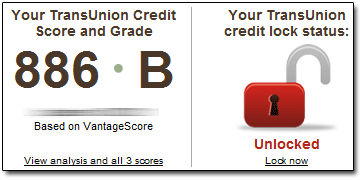
TrueCredit Features: The Bad ...
Like everything else, TrueCredit service has its thorns, too.
- In late 2009, TrueCredit changed its credit-score offering. It now shows your VantageScore, rather than the estimated FICO it had shown previously. The verdict is still out on just how much the credit industry will utilize VantageScores. In any case, similarities can still be drawn between VantageScores and FICOs: If you have a high-ranking VantageScore, you likely have a high-ranking FICO.
- You will have to dodge lots of "unique affiliate offers" once you're logged into your account. Same goes for the emails TrueCredit sends you:

- Fifteen bucks per month ain't peanuts. That's $180 per year.
- The credit-score "Things to Pay Attention To" section is the same as I've always seen with similar scoring services: It's so vague as to be not terribly helpful at all. (Although this could be more useful, I suppose, the lower your scores are. And the less you already know about the credit-scoring system.)
- Did I mention that you'll be deluged with affiliate offers? At every turn?
TrueCredit Reports "VantageScore"
In late 2009, TrueCredit began reporting to users their "VantageScores." Designed to offer some amount of standardization across the three credit bureaus, your VantageScore runs a range of 501 to 990, with 990 being the highest score.
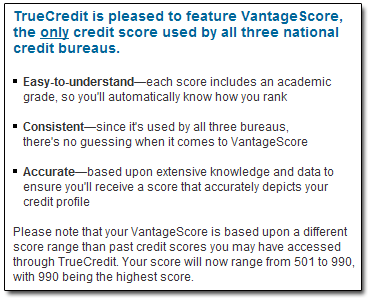
The VantageScore has been around for a while, as I first blog-posted on it (see "How to Check Your VantageScore") in 2006.
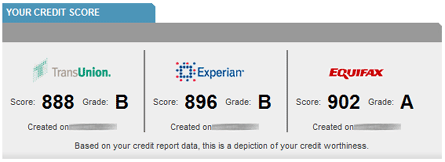
Signing Up With TrueCredit Was Easy
Four short screens. Five minutes. Done.
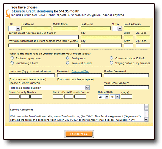
More Screenshots & Aesthetics
Click the thumbnails below to open viewable images in a new window.
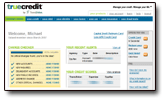
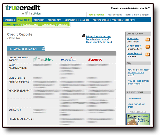

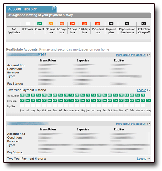
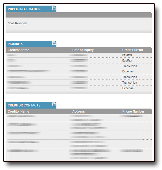
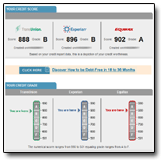
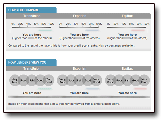
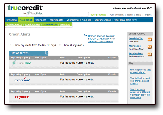
Visually and organizationally, I consider TrueCredit to be pretty good. In most regards, I prefer the layouts of the TrueCredit reports here better than those I've seen from MyFICO and the other credit bureaus.
TransUnion "Change Reports"
In 2008, TrueCredit added a new feature to its service: TransUnion Change Reports.
Since TrueCredit is a TransUnion venture, we can surmise that it's a simple task for them to compare TransUnion credit-report changes across time. Such comparisons are what makes the TransUnion Change Reports so useful.
Here, for instance, is the "Summary" section of a TransUnion Change Report:
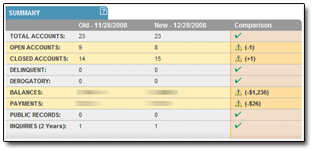
It then shows the same sort of report for every credit entity on your TransUnion report. Here's a report for a Chase credit card:
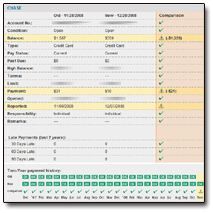
In the examples above, the Change Report clearly shows you ALL the differences between the two most-recent versions of your TransUnion credit reports. I was very surprised to see this feature when it appeared, and I believe it'll be a useful addition to TrueCredit's offerings.
Email Alerts: Security to Your Inbox
When there's a change to your credit report, you need to know about it. This, in the world of credit monitoring, is where the rubber meets the road.
When something changes with your report — an inquiry, a new account, an address change, or whatever — TrueCredit will notify you by email within 24 hours. Additionally, when there's no activity on your report over a certain time period (you can choose either weekly or monthly), you'll get an email confirming that, too:

Ahhh ... no activity. Just what I like to see.
Email Alerts: Putting Them to the Test
Just for kicks, I took the opportunity to try out TrueCredit's email-alert system. On Thursday afternoon, I applied for a business credit card through Citibank's website. The next evening (Friday), when I returned from dining out with my family, I found this in my inbox:
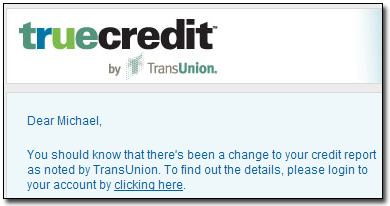
Pretty quick, I thought, given that Citibank probably didn't pull my report until sometime Friday. As instructed by the email, I logged into my account and clicked the CREDIT ALERTS heading.
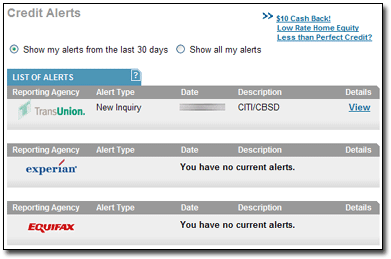
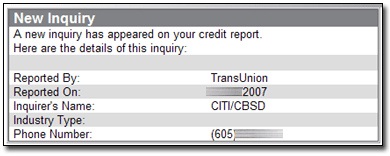
Bingo. There it was, complete with a phone number telling me who to call at Citibank if I had questions about the inquiry. I'd say TrueCredit's alert service performed exactly as promised.
And later, when I opened my ING Direct Electric Orange checking account, TrueCredit was right there to notify me within 36 hours that ING had pulled my credit report.
More TrueCredit Promptness
In late 2008, I allowed Chase to close one of my household's low-limit, unused credit-card accounts. (In other words, they told me the account would be closed unless I used it for at least one transaction by a certain date.)
We decided to not use the card. When Chase closed the account, we found out about it via a TrueCredit email three full days before the snail-mailed "We closed your account due to inactivity" letter from Chase arrived in our mailbox.
View Scoring and Statistical Trends
A feature that is, as far as I know, unique to TrueCredit is its ability to show you the trends of various credit-reporting and -scoring statistics over time. These would include graphical trends in your:
- Available Credit
- Balances/Payments
- Delinquencies
- Total Debt
- Credit Score
- Inquiries
- Debt-to-Income
Each section looks much like this "Available Credit" trend screen:
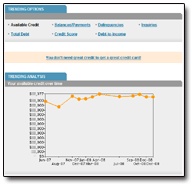
Performance & Operation
The TrueCredit site is easy to navigate, and very well laid-out. From Day One, I've had no difficulty at all finding what I need.
Again, I really would like to see them bring the ads down a notch or two. But that's how it goes.
Pricing & Value
You probably don't have to be told this, but I'll say it anyway: Fifteen dollars per month, per person, isn't throwaway money. Not for me, at least.
But I will say that for me, it is absolutely worth that much to be able to find out, whenever I choose, what's going on with my family's credit reports and scores.
Summary
In her fantastic 2005 book Your Credit Score (review), Liz Pulliam Weston touched on the topic of credit monitoring. She asked the question, "What can't credit monitoring do for you?"
I'd agree very much with that. But now we're also left to determine just who exactly these "better services" are which Ms. Weston mentions. "Most credit monitoring services," she writes, "have serious drawbacks."
- They're not comprehensive. Many credit-monitoring services check your reports on a sporadic basis only, and sometimes only annually. Some services never check in with any bureaus other than the one they're directly associated with.
- They might not provide much of a head start. When does the service update its info? Weekly? Monthly? If they're not checking all three bureaus, the risks for missing important info increase substantially.
- They're costly. As Ms. Weston wrote, the more comprehensive services cost more than $100 per year for daily monitoring of a single bureau's report, plus quarterly updates of the others. "To get ongoing monitoring of all three bureaus," she said, "you'd need to subscribe to several different services and pay more than $200 a year."
In my opinion, TrueCredit passes the test on each of those points. On points one and two, we've seen that TrueCredit pulls all three bureau's reports, and can do so daily basis (with TransUnion) or on a monthly basis (with Experian and Equifax) if you so choose.
On point three? Well, yes, TrueCredit seems a tad pricey. There is no denying that.
But in credit monitoring, as in most aspects of consumer life, value is precisely where you find it.
For us, with the peace of mind that TrueCredit gives my wife and I, that $15 per person per month is a screaming bargain.
Michael • UpdatedMy family has been so pleased with TrueCredit that my sister and I activated TrueCredit monitoring for our mom also — with her approval, of course.
Every day seems to bring new solicitations and offers (via all channels imagineable!) to our aging mom, and to say that she's had some very "trusting" moments would be an understatement. So for the $15 per month that I'll pay for mom's TrueCredit account, my family can be confident that nothing will go on in her credit-related life without us knowing about it.
I say again: In specific-need situations like this, TrueCredit is an absolute bargain.
In December 2007, TrueCredit added a nifty new feature called Change Checker. Now, whenever you log in, your splash page shows you the Change Checker section, and it tells you whether there have been any changes in any designated areas since the last time you visited. It looks like this:
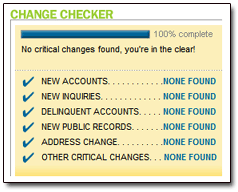
I like the feature — other than the grammatical error in there (that comma should be a semicolon, dangit!). 
| Ratings are on a scale of 1 to 5, with 5 being the top ranking. | |
|
value: Is it worth the money? |  |
|
adaptability: Could this work for me over time? | 
|
|
usage: Is its usage intuitive? Is it professional in appearance and function? | 
|